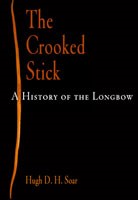The Crooked Stick. A History of the Longbow, Hugh D.H. Soar
Westholme Publishing (imprint of Pen & Sword Books), Yardley 2011
ISBN: 978-1-59416-090-5
Paperback, with illustrations in black and white, appendix, glossary, notes, references for further reading and index
243 pages
£12,99 / €15,99
The History of England’s Most Famous Weapon
In this book Hugh Soar has dedicated himself to the writing of the history of perhaps the most destructive and decisive weapon of the Middle Ages; the longbow. In The Crooked Stick, Soar works his way chronologically through the history of this imaginative piece of weaponry. Although the chapters are short, Soar manages to capture the important developments in the evolution of the early, Mesolithic, hunting bows to the monstrous war bows of the fifteenth century and beyond.
Soar is himself an archery expert, and a successful collector of historic archery equipment too as becomes clear when reading the book. Through his lifelong dedication to the bow, more specific the longbow, he gained a wide knowledge of it and its history. In painting the broader picture of the historical background to which the weapon developed however, Soar is sometimes wide of the mark, especially when he writes about the early Middle Ages. For instance, in his treatment of early Welsh life and society, he nurtures the imagery of a wild, barbaric and ‘noble savage’ people, and fails to sketch a truthful historic picture of the Welsh but instead copies out-dated stereotypes. He goes along with the artificial distinction between ‘warlike Celts’, the Welsh, and their more collected Anglo-Norman adversaries. These were regularly ‘forced’ by Welsh incursions into their territory to send expeditions to the Welsh and teach these ‘untamed mountain men a lesson’ according to the lightly anglocentric author. It becomes even worse when Soar begins to talk of eleventh-twelfth century ‘national character’ where ‘undoubtedly a fine archer and a brave fighter, the Celt was a volatile being and sometimes a stranger to the essential discipline of warfare’. So far the hopelessly out-dated stereotypes an anachronistic nonsense, let’s return to the bow.
Because what Soar has to say about that is much more interesting. He tries to find the origins of the change of the bow as a practical hunting weapon, also useful for self-defence at short range, to the imposition of a much heavier bow when the Crown decided to build a reservoir of ready-to-use archers for warfare. He finds clues in thirteenth-century Robin Hood ballads and Roger Ascham’s Toxophilus, sixteenth-century guide on archery. Soar’s deliberations on the medieval English archery tradition is insightful and varied. He writes about many different aspects of the bow and archer, such as the emergence of the bowyers and fletchers’ guilds and the obligatory rise in poundage for the bows that were to be kept in each household. The wide range of used arrows, the ways of producing the bow and arrow material is not forgotten, as neither is the political incitement to make the longbow a first class military weapon.
It is in narrating the fortunes of the longbow that Soar’s qualities and knowledge truly come to fruition. After an entertaining account of the great battles of the Middle Ages where the longbow won the day for its users; Crécy, Poitiers, Agincourt to name a few, Soar takes us along to the sixteenth, seventeenth and eighteenth century to see how the bow almost disappeared from English society. First of all as a military weapon, although even Benjamin Franklin at one time during the American War of Independence seriously considered to arm his troops with longbows instead of rifles because of a gunpowder shortage. In the end this didn’t happen because powder did arrive eventually, but the story remains remarkable. The survival of the bow was due to its adaptation to the role of recreational sporting tool, as recreational marksmen kept shooting the bow well into the nineteenth century. Despite the ups-and-downs along the centuries, as Soar vividly describes, the longbow kept its attractiveness to certain groups of people. Until the twentieth century these came mostly from the privileged classes, as they had leisure time to devote to the pleasures of shooting the ancient weapon.
In the twentieth century technical developments almost banished the traditional longbow from the archery scene, with inventions as the steel recurve bow conquering the world with great speed. From the 1980’s onwards however, and perhaps due to the archaeological excavation of the Mary Rose ship full of sixteenth-century archery equipment, the traditional longbow has made a glorious comeback under new generations of archers that grew up with technical recurve and compound bows and are now enjoying the peculiarities of the ancient bow as have thousands of archers in the centuries before them. With this book Soar has written a worthy tribute to the mighty medieval war bow and its offspring.
Wouter van Dijk
Interested in the history of archery? Also read the review of Archery in Medieval England

